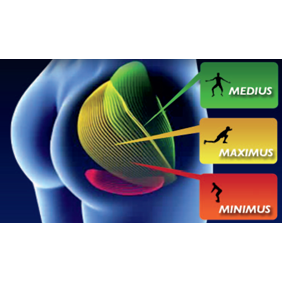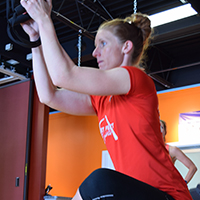Why Do Runners Need Strong Butts?
Out of approximately 640 skeletal muscles found in the human body, there is one muscle group that rules them all – the glute muscles. If you're a runner and all you know about glutes is that they are butt muscles, you'll benefit from knowing more. In addition to making you look great in your running shorts, strong glues will help you run faster, be more efficient and, most importantly, less likely to get laid up with a preventable injury.
What are glute muscles?
 The gluteus maximus (glute max) is the largest of the gluteal muscles and one of the strongest muscles in the human body. It inserts at the iliotibial band* and the gluteal tuberosity of the femur. Its action is to (1) extend and laterally rotate the hip and (2) to extend the trunk.
The gluteus maximus (glute max) is the largest of the gluteal muscles and one of the strongest muscles in the human body. It inserts at the iliotibial band* and the gluteal tuberosity of the femur. Its action is to (1) extend and laterally rotate the hip and (2) to extend the trunk.- The gluteus medius (glute med) is a broad, thick, radiating muscle, situated on the outer surface of the pelvis.
- The gluteus minimus (glute min) is the smallest muscle in the group and is situated immediately beneath the gluteus medius.
Why are glute muscles such a big deal? (We'll narrowed it down to three reasons.)
- Strong glutes provide a powerful hip extension, which is one of the key qualities that separates the tortoises from the hares. It is the bedrock of speed. In order for us to move forward we have to push backwards. And to push backwards, we need strong glutes.
- Strong glutes provide stability. The glute min and glute med are what supports your body when on one leg. If you have a weakness in either of these two muscles, other parts of your body “try” to provide stability, leading to compensation, poor mechanics and, ultimately. injury.
- "Decreased gluteal max strength can contribute to common running injuries such as iliotibial band friction syndrome and patellofemoral pain," says Brian Harthill of Athletico's physical therapy clinic in St. Peters.
So, how do you strengthen your glutes?
The trick is to start at the actual start.
To successfully get the glutes to fire, we have to successfully overwrite the compensatory patterns that have developed over time. We have to activate them in a low load, low stress environment, and positions where surrounding muscles can’t jump in and take over. Here are two ways to do just that:
And let’s not forget...
Sitting for long periods (aka, the desk job) can lead to the gluteal muscles atrophying (or degenerating) through constant pressure and disuse. Simple isometric contractions (or squeezing of glutes) at your desk will keep your muscles turned on while you are plugged in at work.
 Fleet Feet Training Director Brandi Barbre has more than a decade of experience coaching athletic performance, prescribing corrective exercise, and conducting metabolic testing. She has trained thousands of post-collegiate runners over a variety of distances, hundreds of school-aged runners, and dozens of professional athletes (18 NHLers, 11 NFLers, 7 MLBers, and 4 MLSers). Brandi has a Masters in Exercise Science from Southeast Missouri State University, has earned ACSM CPT, NSCA CSCS, and USAW Sports Performance Coach certifications, and is a marathoner (19 fulls; 28 halfs) and triathlete (2 70.3s), herself.
Fleet Feet Training Director Brandi Barbre has more than a decade of experience coaching athletic performance, prescribing corrective exercise, and conducting metabolic testing. She has trained thousands of post-collegiate runners over a variety of distances, hundreds of school-aged runners, and dozens of professional athletes (18 NHLers, 11 NFLers, 7 MLBers, and 4 MLSers). Brandi has a Masters in Exercise Science from Southeast Missouri State University, has earned ACSM CPT, NSCA CSCS, and USAW Sports Performance Coach certifications, and is a marathoner (19 fulls; 28 halfs) and triathlete (2 70.3s), herself.
Connect With Us
see the latest from Fleet Feet St. Louis